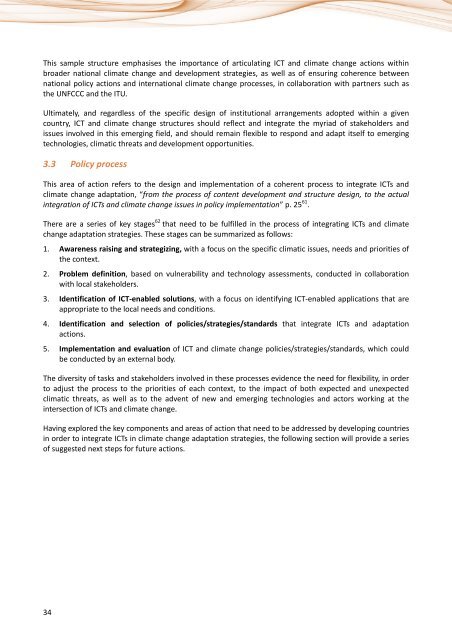Information and communication technologies (ICTs) and ... - ITU
Information and communication technologies (ICTs) and ... - ITU
Information and communication technologies (ICTs) and ... - ITU
Create successful ePaper yourself
Turn your PDF publications into a flip-book with our unique Google optimized e-Paper software.
This sample structure emphasises the importance of articulating ICT <strong>and</strong> climate change actions within<br />
broader national climate change <strong>and</strong> development strategies, as well as of ensuring coherence between<br />
national policy actions <strong>and</strong> international climate change processes, in collaboration with partners such as<br />
the UNFCCC <strong>and</strong> the <strong>ITU</strong>.<br />
Ultimately, <strong>and</strong> regardless of the specific design of institutional arrangements adopted within a given<br />
country, ICT <strong>and</strong> climate change structures should reflect <strong>and</strong> integrate the myriad of stakeholders <strong>and</strong><br />
issues involved in this emerging field, <strong>and</strong> should remain flexible to respond <strong>and</strong> adapt itself to emerging<br />
<strong>technologies</strong>, climatic threats <strong>and</strong> development opportunities.<br />
3.3 Policy process<br />
This area of action refers to the design <strong>and</strong> implementation of a coherent process to integrate <strong>ICTs</strong> <strong>and</strong><br />
climate change adaptation, “from the process of content development <strong>and</strong> structure design, to the actual<br />
integration of <strong>ICTs</strong> <strong>and</strong> climate change issues in policy implementation” p. 25 61 .<br />
There are a series of key stages 62 that need to be fulfilled in the process of integrating <strong>ICTs</strong> <strong>and</strong> climate<br />
change adaptation strategies. These stages can be summarized as follows:<br />
1. Awareness raising <strong>and</strong> strategizing, with a focus on the specific climatic issues, needs <strong>and</strong> priorities of<br />
the context.<br />
2. Problem definition, based on vulnerability <strong>and</strong> technology assessments, conducted in collaboration<br />
with local stakeholders.<br />
3. Identification of ICT-enabled solutions, with a focus on identifying ICT-enabled applications that are<br />
appropriate to the local needs <strong>and</strong> conditions.<br />
4. Identification <strong>and</strong> selection of policies/strategies/st<strong>and</strong>ards that integrate <strong>ICTs</strong> <strong>and</strong> adaptation<br />
actions.<br />
5. Implementation <strong>and</strong> evaluation of ICT <strong>and</strong> climate change policies/strategies/st<strong>and</strong>ards, which could<br />
be conducted by an external body.<br />
The diversity of tasks <strong>and</strong> stakeholders involved in these processes evidence the need for flexibility, in order<br />
to adjust the process to the priorities of each context, to the impact of both expected <strong>and</strong> unexpected<br />
climatic threats, as well as to the advent of new <strong>and</strong> emerging <strong>technologies</strong> <strong>and</strong> actors working at the<br />
intersection of <strong>ICTs</strong> <strong>and</strong> climate change.<br />
Having explored the key components <strong>and</strong> areas of action that need to be addressed by developing countries<br />
in order to integrate <strong>ICTs</strong> in climate change adaptation strategies, the following section will provide a series<br />
of suggested next steps for future actions.<br />
34

















